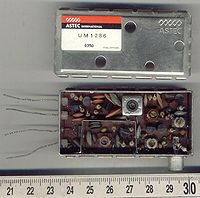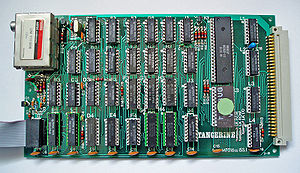
RF modulator
Encyclopedia


Baseband
In telecommunications and signal processing, baseband is an adjective that describes signals and systems whose range of frequencies is measured from close to 0 hertz to a cut-off frequency, a maximum bandwidth or highest signal frequency; it is sometimes used as a noun for a band of frequencies...
input signal and outputs a radio frequency
Radio frequency
Radio frequency is a rate of oscillation in the range of about 3 kHz to 300 GHz, which corresponds to the frequency of radio waves, and the alternating currents which carry radio signals...
-modulated signal.
This is often a preliminary step in transmitting signals, either across open air via an antenna
Antenna (radio)
An antenna is an electrical device which converts electric currents into radio waves, and vice versa. It is usually used with a radio transmitter or radio receiver...
or transmission to another device such as a television
Television
Television is a telecommunication medium for transmitting and receiving moving images that can be monochrome or colored, with accompanying sound...
.
Design
In order to display data information on early analog televisionTelevision
Television is a telecommunication medium for transmitting and receiving moving images that can be monochrome or colored, with accompanying sound...
s, the data must be modulated, or conditioned, to the format that the television expects. TVs were designed to only accept signals through the aerial connector: signals originate at a TV station, are transmitted over the air, and are then received by an antenna and fed into the TV. Thus, other equipment, such as a VCR, DVD player, or video game console, which wishes to send a signal to such an old TV must replicate this process, in effect "faking" an over-the-air signal. Technically, this usually means combining the data with a carrier wave
Carrier wave
In telecommunications, a carrier wave or carrier is a waveform that is modulated with an input signal for the purpose of conveying information. This carrier wave is usually a much higher frequency than the input signal...
at a standardized frequency.
RF modulators produce a relatively poor picture, as image quality is lost during both the modulation from the source device, and the demodulation in the television, but the aerial connector is standard on all TV sets, even very old ones. Since later television designs include composite, S-Video
S-Video
Separate Video, more commonly known as S-Video and Y/C, is often referred to by JVC as both an S-VHS connector and as Super Video. It is an analog video transmission scheme, in which video information is encoded on two channels: luma and chroma...
, and component video
Component video
Component video is a video signal that has been split into two or more component channels. In popular use, it refers to a type of component analog video information that is transmitted or stored as three separate signals...
jacks, which skip the modulation and demodulation steps, modulators are no longer included as standard equipment, and RF modulators are now largely a third-party product, purchased primarily to run newer equipment such as DVD player
DVD player
A DVD player is a device that plays discs produced under both the DVD-Video and DVD-Audio technical standards, two different and incompatible standards. These devices were invented in 1997 and continue to thrive...
s on old televisions.
An RF modulator take the audio and video signal from a PAL
PAL
PAL, short for Phase Alternating Line, is an analogue television colour encoding system used in broadcast television systems in many countries. Other common analogue television systems are NTSC and SECAM. This page primarily discusses the PAL colour encoding system...
or NTSC
NTSC
NTSC, named for the National Television System Committee, is the analog television system that is used in most of North America, most of South America , Burma, South Korea, Taiwan, Japan, the Philippines, and some Pacific island nations and territories .Most countries using the NTSC standard, as...
composite video
Composite video
Composite video is the format of an analog television signal before it is combined with a sound signal and modulated onto an RF carrier. In contrast to component video it contains all required video information, including colors in a single line-level signal...
, RGB, YUV
YUV
YUV is a color space typically used as part of a color image pipeline. It encodes a color image or video taking human perception into account, allowing reduced bandwidth for chrominance components, thereby typically enabling transmission errors or compression artifacts to be more efficiently...
or other composite AV source, and generates a broadcast RF signal that can be fed into a television
Television
Television is a telecommunication medium for transmitting and receiving moving images that can be monochrome or colored, with accompanying sound...
's aerial/coaxial connector.
Multi-channel RF modulators are commonly used in home audio/video distribution. These devices have multiple audio and video inputs and one RF output. Audio/video outputs from source devices such as a DVD player, VCR, or DSS receiver are connected to the audio/video inputs on the modulator. The modulator is then programmed to broadcast the signals on a certain frequency. That RF broadcast is then received by the connected TV. When the TV is tuned to the programmed channel, the audio/video signal of the source device is accessed. RF modulation can become difficult in a CATV system. High pass, low pass, and notch filters must be used to block certain frequencies, or channels, so that the modulator can broadcast the audio/video signal of the source device on that channel.
Uses
Internal RF modulators are commonly found in VCRs, in older video game consoles such as the Atari 2600Atari 2600
The Atari 2600 is a video game console released in October 1977 by Atari, Inc. It is credited with popularizing the use of microprocessor-based hardware and cartridges containing game code, instead of having non-microprocessor dedicated hardware with all games built in...
, NES
Nintendo Entertainment System
The Nintendo Entertainment System is an 8-bit video game console that was released by Nintendo in North America during 1985, in Europe during 1986 and Australia in 1987...
, or Sega Master System
Sega Master System
The is a third-generation video game console that was manufactured and released by Sega in 1985 in Japan , 1986 in North America and 1987 in Europe....
, and in older home computers such as the Commodore 64
Commodore 64
The Commodore 64 is an 8-bit home computer introduced by Commodore International in January 1982.Volume production started in the spring of 1982, with machines being released on to the market in August at a price of US$595...
, Atari 800, and Sinclair Spectrum.
During the 1980s and early '90s, it was common for video game systems that did not have internal RF modulators to provide external units that connected to the antenna jacks of a television. One reason for this is that a device which outputs an RF signal must in general be certified by regulatory authorities—in the US, the FCC—and thus by having an external RF modulator, only the modulator itself needed to be certified, rather than the entire video game system.
TV modulators generally feature analog passthrough
Analog passthrough
Analog passthrough is a feature found on some digital-to-analog television converter boxes. Boxes without analog passthrough only allow digital TV to be viewed on older, analog-only TVs...
, meaning that they take input both from the device and from the usual antenna input, and the antenna input "passes through" to the TV, with minor insertion loss
Insertion loss
In telecommunications, insertion loss is the loss of signal power resulting from the insertion of a device in a transmission line or optical fiber and is usually expressed in decibels ....
due to the added device. In some cases the antenna input is always passed through, while in other cases the antenna input is turned off when the device is outputting a signal, and only the device signal is sent onward, to reduce interference.
In North America, RF modulators generally output on channel 3 or 4 (VHF), which may be selectable, although the Atari
Atari
Atari is a corporate and brand name owned by several entities since its inception in 1972. It is currently owned by Atari Interactive, a wholly owned subsidiary of the French publisher Atari, SA . The original Atari, Inc. was founded in 1972 by Nolan Bushnell and Ted Dabney. It was a pioneer in...
consoles offer channels 2 and 3. In Europe standard modulators use channel 36 (UHF) by default but are usually tunable over part or all of the UHF band.
Modulating a TV signal with stereo sound is relatively complex and most low-cost home TV modulators produce a signal with monaural audio. Even some units that have two audio inputs simply combine the left and right audio channels into one mono audio signal. Some used on very early home computers had no sound capability at all. Most cheaper modulators (i.e. not intended for professional use
Cable television
Cable television is a system of providing television programs to consumers via radio frequency signals transmitted to televisions through coaxial cables or digital light pulses through fixed optical fibers located on the subscriber's property, much like the over-the-air method used in traditional...
) lack vestigal sideband filtering.
Audio RF modulators are used in low-end car audio to add devices like CD changers without requiring dashboard hardware upgrades. For example, a portable CD player's headphone jack is connected to the modulator, which outputs a low-power FM
FM broadcasting
FM broadcasting is a broadcasting technology pioneered by Edwin Howard Armstrong which uses frequency modulation to provide high-fidelity sound over broadcast radio. The term "FM band" describes the "frequency band in which FM is used for broadcasting"...
radio signal, which plays through the car radio. Car FM modulators suffer from loss of quality and interference issues.

